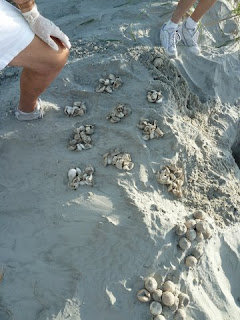SC Nest Counter
Waties Island Sea Turtle Monitors
Waties Island is a 2.7 mile private undeveloped barrier island at the border of North and South Carolina. Under a permit from SC Department of Natural Resources to help protect the sea turtle, we are at it again this season! The site will be updated often, so please feel free to bookmark us and visit us again to see what's new!
Waties Island Nest Counter
Tuesday, October 30, 2012
Love Of Waties
https://picasaweb.google.com/100968854289938621648/LoveOfWaties?authkey=Gv1sRgCPSYuNDknK-maw
Sunday, October 10, 2010
Trip on the DNR Boat Discovery

It was a beautiful day on the water...







Once we were near the mouth of the inlet, a trawl net was dropped into the water. There are so many different animals in the water here: in the first trawl, Katie gathered several fish, including a Hog Choker (got to love that name) and plenty of shrimp. She explained a lot about each animal, even how to tell if you are eating male or female shrimp.

On the second trawl, she brought in a medium to large female horseshoe crab. We learned how to tell the difference between males and females and also heard how their blood is used in the medical field for testing for impurities.



Forked tail fish (faster swimmers), fan tail fish, trout with "buck teeth", eyes that migrate to the top side of flat fish in one day (the Hog Choker) and lots more. Katie also passed around two sting ray barbs; they were nasty looking things - don't step on one of these animals in the water.
All in all, a really great trip. Thank you, Karen, for making this all possible.
Sunday, September 5, 2010
Waties Nest 2 Inventory
We had some help this morning from a budding naturalist, Miles. He was interested in everything - from helping take down the poles to digging up the nest contents.
When we inventoried the contents, there were 88 hatched eggs, 21 unhatched eggs (which included one almost fully formed turtle) and 4 dead hatchlings (no live hatchlings). This gave us a "Hatch Success" of 80% as calculated by Seaturtle.org, and an "Emergence Success" of 76.3% - about average.

Sunday, August 29, 2010
Barriers Behind Nest 2
We also "domed" the nest this morning (loosened the hard packed sand below the surface). This hard layer, which is caused by heavy rains compacting the sand, can make it much harder for hatchlings to make their way to the surface.
There is a black line on the barrier boards which indicates the level of the sand this morning. When checking the nest, if you notice significant accumulations of sand, please try to remove it to bring it back to the original level.
Barb and Steve
Friday, August 6, 2010
Nest #1 Inventory



Thursday Visitors




 s. They also had fun with the ghost crabs.
s. They also had fun with the ghost crabs.It was wonderful to have them visit and hope they'll come back again!
Tuesday, August 3, 2010
Monday Morning Picture

When we checked the nest the morning, we found one dead hatchling in the ghost crab pile and also what sure looked like some new hatchling tracks: only a few inches of tracks here and there, surrounded by lots of ghost crab tracks.
One thing is for sure - every nest is different!




















